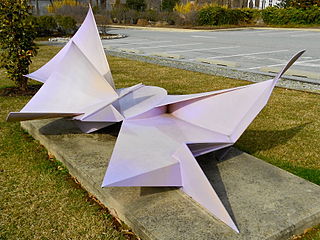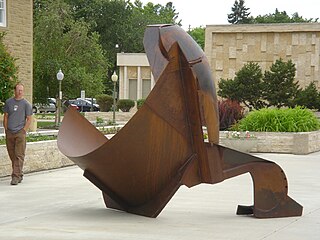
Sir Anthony Alfred Caro was an English abstract sculptor whose work is characterised by assemblages of metal using 'found' industrial objects. He began as a member of the modernist school, having worked with Henry Moore early in his career. He was lauded as the greatest British sculptor of his generation.

The Royal Alberta Museum (RAM) is a museum of human and natural history in Downtown Edmonton, Alberta, Canada, located north of City Hall. The museum is the largest in western Canada with more than 7,600 square metres (82,000 sq ft) exhibition space and 38,900 square metres (419,000 sq ft) in total.

Isaac Witkin was an internationally renowned modern sculptor born in Johannesburg, South Africa. Witkin entered Saint Martin's School of Art in London in 1957 and studied under Sir Anthony Caro and alongside artists including Phillip King, William G. Tucker, David Annesley, and Michael Bolus. Witkin helped create a new style of sculpture which led to this New Generation of sculptors and their innovating abstract forms of modern sculpture reaching and changing the art world. Witkin's abstract works of usually brightly colored fiberglass or wood was noted for its "witty, Pop-Art look".

Bernard Meadows was a British modernist sculptor. Meadows was Henry Moore's first assistant; then part of the Geometry of Fear school, a loose-knit group of British sculptors whose prominence was established at the 1952 Venice Biennale; a professor of sculpture at the Royal College of Art for 20 years; and returned to assist Moore again in his last years.

Big Things was a large-scale steel sculpture exhibition series organized by the North Edmonton Sculpture Workshop for the Royal Alberta Museum's outdoor South Terrace. The exhibition series began as an effort to "expose the public to the richness and diversity of contemporary sculpture in steel, while encouraging a critical dialogue between artists."
Howard McCalebb is an American abstract sculptor.

Edmonton Contemporary Artists' Society (ECAS) is an international artists' exhibition collective founded in 1993, based in Edmonton, Alberta, Canada.

Phillip King PRA was a British sculptor. He was one of Anthony Caro's best-known students, even though the two artists were near contemporaries. Their education followed similar trajectories and they both worked as assistants to Henry Moore. Following the "New Generation" show at the Whitechapel Gallery, both Caro and King were included in the seminal 1966 exhibit, "Primary Structures" at the Jewish Museum in New York representing the British influence on the "New Art". In 2011, his work was represented in the Royal Academy exhibition on Modern British Sculpture which explored British sculpture of the twentieth century.

Robert Byron Willms is a Canadian sculptor and teacher, best known for creating assembled, abstract steel sculptures.

Sheila May Girling, Lady Caro was a British artist who worked across painting, collage and clay. She was one of the first British artists to use acrylic medium and is known for working directly on the floor to immerse herself in the detail of her canvases. Girling was married to the sculptor Sir Anthony Caro.
The Geometry of Fear was an informal group or school of young British sculptors in the years after the Second World War. The term was coined by Herbert Read in 1952 in his description of the work of the eight British artists represented in the "New Aspects of British Sculpture" exhibition at the Biennale di Venezia of 1952.

Ivor Abrahams was a British sculptor, ceramicist and print maker best known for his polychrome sculptures and his stylised prints of garden scenes. His career long exploration of new subject matter, novel techniques and materials made his art dealer, James Mayor, describe him as Europe's equivalent of Robert Rauschenberg.

Douglas Hector Haynes was a Canadian abstract artist and teacher.

Ryan McCourt is a Canadian artist best known for his sculptures. He lives in Edmonton, Alberta.

The North Edmonton Sculpture Workshop (NESW) is an artist collective, or artist-run initiative, centred on a co-operative shared studio in Edmonton, Alberta, focused on "the creation and promotion of ambitious contemporary sculpture made using industrial processes and materials". The NESW name makes a symbolic reference to the cardinal directions in allusion to the idea of boundless exploration.

Andrew Michael French is an English-born abstract sculptor. A one-time pupil of Peter Hide, French is best known for upright, large-scale welded sculptures made of brightly painted steel. With sculptors Mark Bellows, Bianca Khan, Rob Willms, and Ryan McCourt, Andrew French is identified as part of the "Next Generation" of Edmonton Sculpture.

Twenty Four Hours is a 1960 painted steel sculpture by Sir Anthony Caro, located in Tate Britain, central London, England. It was purchased by Tate in 1975.
David Annesley is a British sculptor who rose to prominence in the 1960s.
Douglas Bentham has been since the late 1960s, acknowledged as one of Canada's pre-eminent producer of large-scale welded steel sculpture.

















